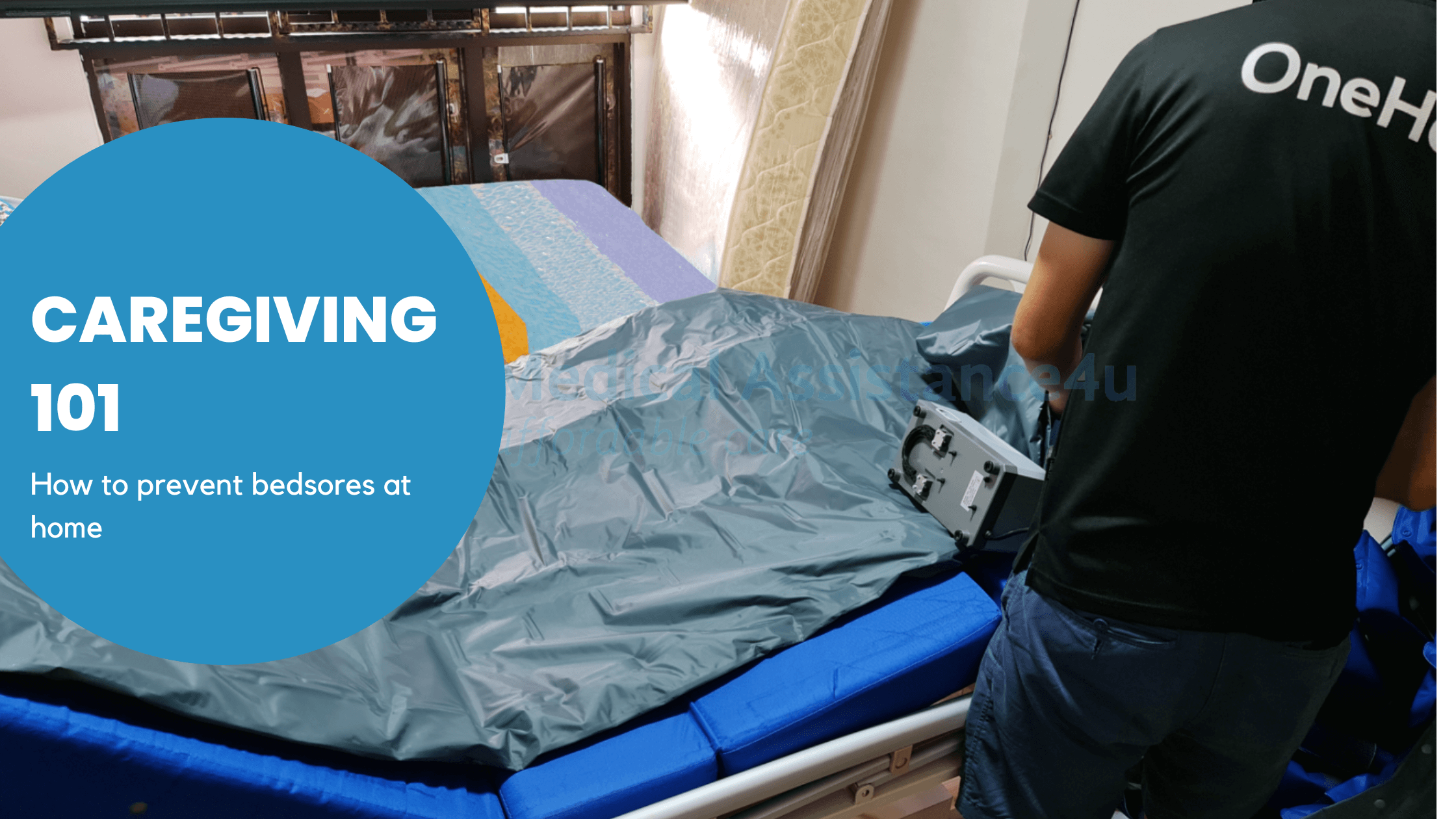Caregiving 101: How To Prevent Bedsores
- Medicalassistance4u
- January 31, 2023
- Bedroom Assistive, Caregiving, Home Care, Hospital Bed, Hospital Bed Accessories

Bedsores are caused by prolonged pressure on the skin. This usually happens to individuals who stays in a fixed position for a prolonged time in beds or wheelchairs with minimal movement.
Normal home use beds are not suitable for users who are confined in bed due to health issues. Caregivers will have a hard time taking care of the patient when they have to turn the patient manually. Unsuitable use or absence of equipment increases the chance of injury on both the caregiver and the patient.
In this article, we will share more about bedsores, how they are caused and preventive measures against them at home.
1. What Are Bed Sores?
Have you ever bit your lips by accident, resulting in an ulcer? The sharp and aching pain you experience anytime another object touches the ulcer?
Bed Sores are exactly that; ulcers. More specifically, they are pressure ulcers that are injuries to the skin and underlying tissues. Bed Sores are usually located on “bony” areas such as the tailbone, hips, ankles and heels.
Bed Sores pose a higher risk to frail older adults. This is especially true when they are immobile or bedridden. When they are not turned or positioned correctly, Bed Sores can develop.
Alternative terms used to refer to Bed Sores are:
- Pressure Sores
- Pressure Injuries
- Decubitus
2. Causes Of Bed Sores
There are 3 factors that contributes to the development of Bed Sores
1. Pressure
Just like with every part of our body, blood needs to flow in order for our tissues to continue functioning. If a constant and significant pressure is placed on any part of our body, it may lessen the blood flow to our tissues.
Blood flow is essential for delivering oxygen and nutrients to tissues. Without good blood circulation, essential nutrients might not reach certain parts of our body. And without nutrients, our skin and nearby tissues will become damaged and might eventually die.
Immobile and frail older adults are especially susceptible to this because of their inability to move as freely. Bed Sores commonly occur in “bony” areas that are not well-padded by muscle or fat.
Some examples include:
- Back or Sides of the Head
- Rim of the Ears
- Shoulder Blades
- Spine
- Tailbone
- Elbows
- Hips
- Back or Sides of the Knees
- Ankles
- Heels
2. Friction
Friction occurs when our skin rubs against clothing or bedding. Fragile skin is more vulnerable to friction damage, especially if the skin is moist. Be it from perspiring or after a bath.
3. Shearing
Shear occurs when 2 surfaces move in the opposite direction. In the context of Bed Sores, the 2 surfaces are referring to our skin and bones.
Consider a patient in bed whose head is in a raised position.
The force of gravity pulls the skeleton down, but because of friction, the surface of the skin remains attached to the bed. As a result, the blood vessels between the bones and skin become compressed and blood flow is interrupted.
3. Symptoms Of Bed Sores
There are 4 stages of severity of Bed Sores, ranging from least severe (Stage 1) to most severe (Stage 4).
1. Stage 1
The area looks red and feels warm to the touch. With darker skin, the area may have a blue or purple tint. It may burn, hurt, or itches.
2. Stage 2
The area looks more damaged and may have an open sore, scrape, or blister. There may be significant pain and the skin around the wound may be discolored.
3. Stage 3
The area has a crater-like appearance due to damage below the skin’s surface.
4. Stage 4
The area is severely damaged and a large wound is present. Muscles, tendons, bones, and joints can be involved. Infection is a significant risk at this stage.
4. What If Bed Sores Are Left Untreated?
As with any wounds, if left untreated, Bed Sores may lead to dire outcomes. For untreated Bed Sores, the following complications may occur:
- Sepsis, or severe infection that has already spread in the bloodstream
- Cellulitis or swelling and inflammation of the involved tissues
- Infections affecting the bones or joints
- Abscess or the collection of pus
- Squamous carcinoma, a type of cancer
5. How To Prevent Bed Sores?
Prevention is always better than cure. Here are some tips and strategies to help prevent Bed Sores.
1.Repositioning to relieve pressure on a specific area occasionally. Immobile or fragile older adults should receive help from others.
2. Use of right tools
Depending on the situation, there are a few tools to reduce the risk of bed sores on wheelchairs and bed:
Hospital bed
a. Air Mattress
Insert products: air mattress, anti-sore cushion, 3 function hospital bed, bed back support, triangle cushion etc
- Proper skincare, which includes keeping your skin clean and dry. Do this cleansing routine regularly to limit the skin’s exposure to moisture.
- Healthy and balanced nutrition diet.
In the case where a person is already afflicted with Bed Sores, here are some ways to help prevent the condition from worsening.
- Barrier cream may be prescribed by the doctor to protect the skin from elements like urine and feces. Likewise, the patient might need an ostomy or urinary catheter insertion
- Wound cleaning and bandaging for open wounds. Topical or oral medicines may be needed.
- Wound debridement or removal of dead tissues; only trained healthcare persons can do this.
- Surgery to “patch” the wound using a pad of muscle or fat tissues from another part of the body.
Do note that interventions for Bed Sores, regardless of stages, should be unique to the individual. Do consult your doctor for better clarity.

